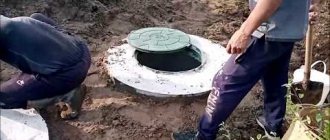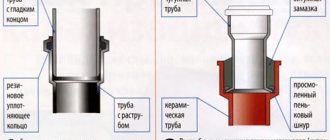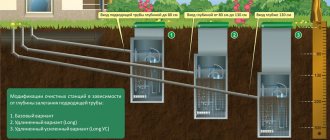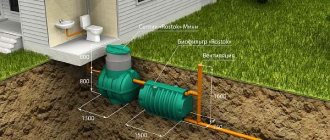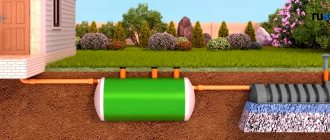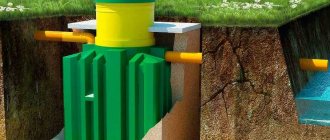Greetings, my dear readers.
Sorry I haven't written for so long. A whole bunch of problems have accumulated, both at home and at work, not only did I sit without the Internet for two weeks - death, melancholy.
Today I will tell you the secret of the ancient diggers and teach you how to dig a hole correctly - in case it comes in handy for someone! It doesn’t matter whether you’re digging or digging, it doesn’t matter what you’re digging for - you’re digging a shambo, a drain hole for waste products, a sewer, you’re digging a hole for a garage or a toilet - the main thing is that you must understand that after reading this article you will become a digging Jedi, only damn, instead of a laser pointer you will have a shovel! So, let's get started my tireless hands!
We made the markings, again I will repeat to you that it doesn’t matter why you are digging, even just for the sake of it. What a romance - he took a shovel and went. As my grandfather said, and his grandfather told him - dig deeper, throw further, rest while you fly!
So, my one-assed, two-bunched creatures - let's look at all the options through the prism of a shovel!
How can I dig a hole for a post?
You can make a hole for a post with a shovel, drill or digger. Each method has its own advantages and disadvantages:
- Shovel. One of the advantages is that with its help, shovels can easily dig wide holes, which are mainly needed for installing pillars. The disadvantages include the fact that people with poor physical fitness will not always be able to dig a hole of the required size without any problems.
- Boer. There are two options for this design: a manual drill and a motorized drill, the rental of which is not affordable for everyone. It is also necessary to apply force to a hand drill, but much less than to a shovel. Therefore, most often masters give preference to it. There is also a special technique that is used if it is necessary to make a depression in a short time. Since it is impossible to quickly dig a hole for a post without it.
Hand drill Source rozetka.ua
- Digger. This tool is designed for digging holes manually, without using a shovel. The advantages: no need to use much effort, minimizes time consumption. The disadvantages include the fact that it is difficult to use on hard ground, problems arise with dry soil, and also, if you need a hole of 1.5 m, then only 1.1 m can be made with diggers, which is not suitable for such a case.
But it is important to remember that before you dig a hole for fence posts, you need to make calculations and preparations.
Digger for digging holes Source alicdn.com
Results
Summarizing the above information, you should group the main points that you need to remember when deciding to dig a ditch for the water supply system yourself:
- before you start digging, you need to determine the parameters of the future hole: configuration, width and depth;
- the shape of the section must be chosen based on the characteristics of the soil in order to prevent the possibility of the walls collapsing;
- how wide and deep the ditch will be is determined by the level of freezing of the soil layers and the convenience of excavation work;
- at the stage of marking implementation, it is necessary to keep in mind the location of other communication connections available on the territory;
- The digging method should be chosen in accordance with financial capabilities, as well as taking into account the presence or absence of free access for special equipment.
The need to organize water supply arises both in a residential building and in a summer cottage. When figuring out what is used to dig trenches for water supply, we must not forget about the quality characteristics of drinking liquid. To get truly clean drinking, you should use special filtering devices. Thus, ours is one of the leaders in the production of water treatment equipment. The quality of the company's products is repeatedly confirmed by years of successful work in this area and reviews from grateful consumers.
Preparation and calculations
You cannot install poles without first making calculations. Also, the future location of the fence must be indicated on the site plan. After this, you need to calculate the number of pillars, and then purchase the material.
Before you drill a hole in the ground for fence posts, you need to familiarize yourself with certain rules:
- During calculations, it is necessary to correctly determine the distance from one pillar to another. It will depend on the area of the site, as well as on the weight and size of the canvas that will be used as a fence and attached to the support. Often this distance is no more than 3 m
- The hole must be made wider than the cross section of the pillar. But it also should not be too wide, otherwise the soil will be too loose. If the hole is made narrow, then concreting will be impossible.
The post must be carefully aligned Source mahis.ru
See also: Catalog of companies that specialize in the construction of fences and enclosures.
- To determine the number of holes, you also need to make calculations. The length of the fence perimeter is divided by the distance between two posts that stand next to each other. These calculations must be made to ensure that the number of pillars is optimal. With a smaller quantity and a larger distance between them, the canvas may sag, and if you purchase a larger quantity, it will be too expensive.
- It is important to remember that the higher the fence, the closer to each other the posts should be installed.
- The depth of the holes depends on the soil. The harder it is, the smaller the hole can be made. But if there is sand or clay in the soil, then the depressions should be larger, since such soil is not very stable. And if with solid soil the depth of the hole can be made up to 1 m, then with sand or clay it is advisable to dig more than 1.5 m.
- Before digging holes, you need to find out if there are underground communications in that place.
It is also important to remember that the calculations must be made accurately, without the slightest errors, otherwise the fence may warp or fall.
Fence after incorrectly installed poles Source khersondaily.com
↑ Dowsers
We approached digging a well very thoroughly, having read all the available literature on this topic. We were the first in our settlement in this matter, so there was no one to advise. On the one hand, it took quite a long time due to trials and “reinventing the wheel,” but on the other hand, it was very interesting and creative.
From books we learned that water lies in layers in the “pie” of earth rocks. At the very top, after rains, perched water accumulates, which is not suitable for the well and should not fall into it. And deeper in the sand between layers of clay lies groundwater. I was very surprised that groundwater forms underground streams and rivers, sometimes not inferior to ordinary rivers. It turns out that you can’t dig a well in any place, but only where the underground channel runs
. This was confirmed by a story about a well in one of the villages in the area, where they dug 14 meters literally on the shore of a lake and never reached the water!
Dowsers are engaged in searching for suitable places for a well. But first we need to start looking for the dowsers themselves. Where and how to find them? In rural areas, the main help in this is communication with people. You arrive in a village, notice an older man who looks like a local, not a seasonal summer resident, and he will tell you. As an urbanite and even with a Baltic mentality, at first it was difficult for me to get used to this approach, but it works great.
But first we need to start looking for the dowsers themselves. Where and how to find them? In rural areas, the main help in this is communication with people. You arrive in a village, notice an older man who looks like a local, not a seasonal summer resident, and he will tell you. As an urbanite and even with a Baltic mentality, at first it was difficult for me to get used to this approach, but it works great.
I jokingly remarked that it was necessary to invite either one dowser or three. And so it turned out - it took three dowsers to examine our site, and each did it with his own method. Some willingly shared their knowledge, while others maintained the veil of mystery and exclusivity.
I understood the idea of dowsing this way: underground water flows have magnetic properties, just like the human body, so when they come close you can feel them. Verkhovodka does not have this property. Since water underground flows in a line, it is wise to walk around the perimeter of your land to search. Within the boundaries of the site, we can assume that the water vein is a straight line, so it is enough to identify two or three points, for reliability - more. You can dig a well anywhere on the formed line.
Verkhovodka does not have this property. Since water underground flows in a line, it is wise to walk around the perimeter of your land to search. Within the boundaries of the site, we can assume that the water vein is a straight line, so it is enough to identify two or three points, for reliability - more. You can dig a well anywhere on the formed line. The depth of the water is determined by diligent digging. An approximate clue could be the depth of a well nearby, the water level in a lake or river.
The depth of the water is determined by diligent digging. An approximate clue could be the depth of a well nearby, the water level in a lake or river.
The first to look for water was an acquaintance who, upon arrival, jokingly asked: “Will you bury me if I show you a place without water?” They promised not to bury the dowser. The dowser took two aluminum wires right from the warehouse of the necessary things in the common house, bent them with the letter G (the short end is the width of the palm, the long end is about forty centimeters) and we went in search of happiness (water).
They promised not to bury the dowser. The dowser took two aluminum wires right from the warehouse of the necessary things in the common house, bent them with the letter G (the short end is the width of the palm, the long end is about forty centimeters) and we went in search of happiness (water).
Aluminum G-shells are clamped in fists by the short ends, the hands are brought together in front of each other so that the long ends point forward, parallel to each other. You need to hold the wires tightly enough so that they do not wobble to the sides from your steps. Above the water, the residential frames intersect and the larger, the closer the water or the stronger the flow.
Our neighbors found water instantly; as soon as the frames were lifted, they immediately closed in a cross. By the way, it turned out that the water vein surprisingly accurately followed the path. Wow!
It turned out to be more difficult with our site. We walked along it like a “locomotive” up and down, regardless of the landscape and obstacles. From the outside it probably looked funny. In places with water they immediately stuck twigs into the ground.
We walked along it like a “locomotive” up and down, regardless of the landscape and obstacles. From the outside it probably looked funny. In places with water they immediately stuck twigs into the ground.
The location of the house is tied to the well, therefore,
until you decide exactly on the water, it’s too early to start planning the site
. The part of the hill where we thought to build a house is called Sahara. But the water vein was found in a completely different place. I was taken aback by this at first. Ideas about the estate somehow swam in my head and began to dissolve. But looking at the situation with fresh eyes, Tatyana and I found many advantages in such a change
The part of the hill where we thought to build a house is called Sahara. But the water vein was found in a completely different place. I was taken aback by this at first. Ideas about the estate somehow swam in my head and began to dissolve. But looking at the situation with fresh eyes, Tatyana and I found many advantages in such a change
Our water vein runs straight across the hill, so there is no point in guessing its direction across the landscape. It happens that water flows uphill under pressure. The bed of an underground river can stretch for tens of kilometers, try to guess!
To be sure, we decided to invite one more dowser. The second specialist was looking for water, holding a similar L-shaped metal rod to his chest, only one, thicker and one and a half times larger. In the place of the water vein, the rod is attracted to the heart, and in others it “fans out” (swings in all directions). In general, a mysterious method.
And then the funny assumption about the three dowsers was confirmed: the second person pointed out the water in the middle of the “Sahara”, and in other places, he said, there is no vein or it is very deep. Such a surprise! And where to dig? In such a difficult situation, there is only one way out - go to Epimachovo! This is such a secret village, which is very difficult to find: the sign stands in the depths behind an inconspicuous turn, and many, “for clarity,” call the village after the neighboring one - Kuznetsovka.
Such a surprise! And where to dig? In such a difficult situation, there is only one way out - go to Epimachovo! This is such a secret village, which is very difficult to find: the sign stands in the depths behind an inconspicuous turn, and many, “for clarity,” call the village after the neighboring one - Kuznetsovka. But a lot of wonderful things awaited us in Epimachovo! They found a dowser with tremendous experience, and they also accidentally met a car with a crane that... was unloading well rings. In addition, beautiful snails were recruited to live on our estate. Class!
But a lot of wonderful things awaited us in Epimachovo! They found a dowser with tremendous experience, and they also accidentally met a car with a crane that... was unloading well rings. In addition, beautiful snails were recruited to live on our estate. Class!
The third dowser, a kind, positive grandfather, immediately found one vein, then another, and with great effort they were able to bring it to the place where the house would be. He easily found water there too, and taught Tatyanka to walk with a willow twig. It’s not the Sahara that we have, but the sea-ocean 
Where the water runs underground, the twig rises up on its own, and if you go further, it tilts back.
As a result, we formed a whole forest of twigs indicating water places. This made a flock of birds very happy, flying from stick to stick with lively chirping.
Drilling holes for poles
If you need to make a lot of holes, then it is better to choose a garden auger and sharpen its edges and tips. Before quickly drilling a hole for a post, you need to mark the places where the recesses will be, and then start working. The drill is installed vertically and rotated by pressing the handle. On clay soil at a depth of 0.3 - 0.4 m, it is more difficult to turn the drill. To make the task easier, you can pour half a bucket of water into the hole, which will soak the soil in less than 5 minutes. After these steps, the handle turns without problems.
If the drill is firmly stuck in the soil and cannot be removed, then it is necessary to loosen it in different directions. This will loosen the soil a little, making it easy to get the tool out. Adhered dirt can be easily removed with a knife. To minimize time costs, you can make several small holes and fill them with water, then the ground will be well soaked and the work will be easier.
The drill makes a neat hole for the post Source onlypatriot.ru.com
Who is excavating the grave? Price range for services
The cost of work in winter depends on the organization that provides the services, as well as on the region. However, a noticeable difference in price is observed between individual entrepreneurs and legal entities. The larger the company, the wider the range of services and the higher the professionalism (speed of digging graves), the more the cost of the work will differ.
Hired workers or friends of the deceased
Most often, the most reasonable price is set by hired workers. But among them there are those that require more than others. If you contact hired workers, you need to clarify how they dig graves in winter - what tools they use. Efficiency and speed will depend on this. Maximum price – 9 thousand rubles. in summer and winter the cost increases by an average of 2 thousand rubles.
You can ask loved ones for help - relatives or friends of the deceased. The cost of the work may be symbolic, given the circumstances, but the period for completing the work will increase.
If you ask your relatives for help in digging a grave, this will reduce the cost of a funeral, but in this case you should be wary of failures and misfortunes, since it is believed that relatives should not do such work for their neighbor - a bad omen.
Ritual services. Factors determining the price of digging
The maximum cost increases to 12 thousand rubles. in summer. When winter comes, the price increases to 20 thousand rubles. This is the highest price category, but funeral services, as a rule, offer a range of services. The cost may change due to factors:
- presence of vegetation (stumps) on the site;
- height of the deceased;
- coffin parameters (non-standard);
- age (children, adults);
- new grave, subburial;
- placing an urn or coffin in a hole.
Cemetery administration
The cost of services provided to prepare a grave for a funeral may vary. Depends on the region, the pricing policy of the cemetery administration, if you do not take into account the main factors that influence the cost (given above). The price can vary between 10-13 thousand rubles.
Cemetery workers services
How to dig a hole for a post
Before you dig a hole for a post without a drill, you also need to mark the places where the recesses will be. The best way to do this is with signal tape or any other bright thread or fabric. This way the master will not crawl out of the frame and the hole will not be too wide. If you don’t have fabric or tape, you can simply place stones in the corners, which will also serve as a kind of limiter.
If it is not possible to make a hole with a drill, then you can use a shovel or digger:
- When all the lines are marked, you can start digging. The top layer of soil is often removed without problems. But the lower it is, the more difficult it is to insert a shovel into the soil. In this case, you can begin to loosen the soil with a bayonet shovel, then it will be easier to remove the soil. Such actions must be performed until the recess reaches the desired size.
↑ Installation of rings
And now the decisive moment has come for installing the rings. On a sunny, fine day, a roaring racket began in our quiet area. It turned out to be difficult to dock two cars, one of which was traveling across the border from Belarus, but I had prepared myself in advance for the most unexpected turns.
The crane-timber loader has excellent cross-country ability and got to our site normally, but the Kamaz with the rings skidded in a ravine, we had to lay down branches, but it eventually got to the place. The drivers of the cars are masters of their craft, they maneuvered between the trees on huge trees so expertly! Wow! The road on which I had been traveling calmly all summer was destroyed all at once.
The drivers of the cars are masters of their craft, they maneuvered between the trees on huge trees so expertly! Wow! The road on which I had been traveling calmly all summer was destroyed all at once.
At noon, Operation X began. Two cars, a bunch of men, including settlers who came to help. And all this moves and makes noise While the rings were being unloaded, the guys and I quickly smeared the upper edge of the rings with cement mortar. I bought cement for 500 marks and, according to the advice from the book, mixed it with sand 1 to 2. The best idea was to wet the rings first, but in the chaos we did it dry. And it was also necessary to monitor the unloading, because the workers’ goal was to make everything as simple and fast as possible.
Two cars, a bunch of men, including settlers who came to help. And all this moves and makes noise While the rings were being unloaded, the guys and I quickly smeared the upper edge of the rings with cement mortar. I bought cement for 500 marks and, according to the advice from the book, mixed it with sand 1 to 2. The best idea was to wet the rings first, but in the chaos we did it dry. And it was also necessary to monitor the unloading, because the workers’ goal was to make everything as simple and fast as possible.
The first ring got caught somewhere on the wall and became not quite straight. I tried to dig under him, but the excitement at the top did not allow me to complete the job. We decided to press down with a second ring to level the first. And then I made a mistake: I stayed inside the shaft while installing the second ring. No, nothing happened to me, I helped with the installation. It's just not worth the worries of your loved one. One way or another, an amazing discovery awaited us - the rings turned out to be not round, but oval. Even it up, don’t straighten it out, there’s still a gap somewhere.
I tried to dig under him, but the excitement at the top did not allow me to complete the job. We decided to press down with a second ring to level the first. And then I made a mistake: I stayed inside the shaft while installing the second ring. No, nothing happened to me, I helped with the installation. It's just not worth the worries of your loved one. One way or another, an amazing discovery awaited us - the rings turned out to be not round, but oval. Even it up, don’t straighten it out, there’s still a gap somewhere. The funny thing is that in the end the top ring became even, almost level. Sometimes the sum of irregularities gives an even result
The funny thing is that in the end the top ring became even, almost level. Sometimes the sum of irregularities gives an even result
Installing the ring resembled some kind of team game. The man on the manipulator did not see how the ring became; an assistant showed him with commands. During the final installation, everyone unanimously adjusted the ring, which capriciously swayed slightly from side to side, unable to be controlled. And when it once again appeared exactly above the lower ring, the people cheerfully waved their hand, “Come on!” and the tap plopped the ring down. Sometimes the game was repeated several times.
And during all this noisy work, a stork flew to our site and calmly began to walk nearby. We took this as a good sign. We actually did very well. At twenty minutes to two the cars left and it became quiet again, only the rustling of aspen leaves in the wind pleasantly pleased the ears. Less than two hours seemed like a whole day.
That day we heard a lot of words of praise for what we had done, for our ingenuity, the village resident even “gave us a medal.” But the most pleasant and desirable were the words of my beloved. What inspiring power they have!
Briefly about the main thing
You can dig a hole for a post using several tools: a shovel, a digger, a drill and a mechanical drill, which will cope with the task in a short time.
Before you start work, you need to make certain calculations: how close the pillars should be to each other and how many there will be. You also need to know what kind of soil the work will be done on. If it is too hard, then it needs to be moistened; if it is too loose, then problems may arise with it during installation of the post. If you put it in loose soil, it may not stick well to it. In this case, the hole needs to be made deeper.
It is better to make formwork from reinforcement; it will be more durable. The concrete mixture should have a consistency similar to sour cream. After it is filled and the pole is installed, it is necessary to remove the remaining air inside by vibration.
Ratings 0
Types of septic tanks
The simplest septic tank is a cleaning structure consisting of a single container - it processes wastewater using microorganisms. However, this option can be used provided that no more than two people live in the house. Read also: “How to make a drainage hole correctly in a private house.”
A two-chamber septic tank has a more complex design. The waste liquid first flows into the first container, where large waste settles. Then the bacteria begin to process the contents. The first chamber is connected to another container via a drain pipe. Thus, a fine-grained, purer liquid enters the second part of the septic tank. There the wastewater finally settles.
The second tank has a similar device as the first part of the treatment plant. In it, bacteria continue to process wastewater. Both chambers are cleaned approximately 1-2 times throughout the year. The output from the septic tank is water that is quite suitable for use for technical purposes, for example, for irrigation. It can also be dumped into a nearby body of water.
Laying sewerage using the HDD method
The installation of sewerage without a trench using the HDD method is becoming increasingly widespread.
Quite often there are comments that, despite their advantages, special HDD equipment is too heavy and massive. To transport it, it is necessary to use trailers and trawls, which prevents the installation from entering areas with limited space. This applies to cottage villages, areas with dense urban development, and areas with an abundance of communication lines.
However, this obstacle has long ceased to be significant, since there is HDD technology with minimal dimensions. The installation is moved using a car tow truck. Sewer installation using the HDD method in cramped conditions is carried out using modern super-precise locating equipment. Laying of sewer pipes occurs in accordance with all established rules, observing the required slope and without any harm to communications already laid in the neighborhood.
Correct “marking” of the site
An important role in the formation of an “uncultivated” vegetable garden is played by the number of beds and paths between them. To begin with, you should make a level path along the perimeter of the garden so that you can drive up with a wheelbarrow to any point. Then you should outline the direction of the beds and begin to “conquer” the garden space using a flat cutter.
Having formed several beds, you should level their surface with a small rake, leaving low sides. It may seem that the soil in new beds dries out instantly, but this is only true for the surface 3-5 cm layer. At greater depths, moisture remains, which makes it possible to grow carrots, onions and many other crops.
It is easier to create your own microclimate on an area divided into zones
In the first year after harvesting, you need to sow green manure (mustard, phacelia or fenugreek) so that a nutritious “cover” is formed on the soil for the winter. Already next spring the soil will “breathe deeply” and become soft and pliable.
Perhaps such methods will seem unacceptable to some: they are not suitable for all climatic zones. But one thing is obvious - deep plowing of lands over time leads to their impoverishment and degeneration. So you need to manage wisely!
What is needed for a pit?
To make digging a hole more convenient, you will, of course, need a shovel. It's better to take fiskar. It’s more convenient to work with a full-size shovel: you don’t have to bend over, and it’s easier to throw back the earth. And when working in a small hole, there is nothing better than a shortened fiskars. Thanks to their curved shape of the handle, it is convenient for them to collect soil from the bottom of the pit. If you have a simple straight garden shovel, then you will definitely ruin its health.
Now let's talk about the device, or more precisely about the search coil. For digging foundations, it’s best, but what’s better... you need to take a sniper coil, preferably DD and preferably high-frequency. So as not to miss any small targets, be it scales and small silver or copper.
For a little trick we need a magnet! We will use it to catch nails and other ferrous metal debris from the dump, which drowns out useful signals. A search magnet, magnetic trawl or homemade magnetic bundle will do. It can be made from powerful magnets from hard drives, speakers and any other strong magnets that can be attached to a wooden plank.
Since the spring before last, I took care of the future and bought a 4.5″ Garrett Ace Super Sniper reel for 2800 rubles for my device. During the crisis, its price jumped to 5k. I considered alternatives from other reel manufacturers, but decided to go with Garrett. I will write about it in more detail later.
Laying depth of the sewer system
For the efficient operation of treatment facilities, the installation depth is of great importance.
The most important factors influencing the choice of laying depth of sewer pipes are the following:
- Availability of groundwater, level of soil freezing. For different climatic regions, these conditions will vary greatly.
- The location of the input endpoint. This could be a collector of a centralized system or a septic tank on a private country plot.
- Surface dynamic loads created by passing traffic.
- Possible geological movements of different types of soil - sands, quicksand.
- Economic feasibility of excavation work.
Considering that in individual housing construction sewer systems are planned to be gravity-flow, the final point of wastewater reception will be of decisive importance.
The angle of inclination must be maintained throughout the entire length of the sewer line. If this length is large and there are angles of rotation, the services of surveyors will be needed.
When constructing an individual residential building, two indicators are taken into account to calculate the necessary and sufficient depth of the trench - the distance of the septic tank and the angle of inclination.
If the septic tank is installed at a great depth, this will lead to increased cost of excavation work and inconvenience of the processes for periodically cleaning the septic tank from solid contaminants.
In a private house, the drain line is always washed with hot water from the kitchen or bathroom. In the absence of drains, it stands empty; thanks to the angle of inclination, it is always warmed by warm fumes from the septic tank. Defrosting of the line is excluded.
Step by step procedure
To dig a trench for any type of pipeline, use a general plan of action:
Make markings . To do this, use pegs and string. The stakes are inserted into the ground along the entire length of the trenches, guided by the diagram. Then a string is pulled between the stakes to mark the width of the trench.
After digging a trench, its bottom is compacted with special tools. This is a vibrating hammer or homemade device for compacting soil.
How to make it easier to dig trenches by hand.
You need to dig a narrow trench in your dacha to lay a pipe. Well, the depth of the trench should be somewhere at least 2 shovels (preferably deeper, but I think I simply can’t physically handle it). The length of the trench is 200 m. You will have to dig by hand with a shovel. Who has ever had to dig something like this? And is it possible to somehow make your work easier in terms of making some additional equipment for digging?
Pavell wrote: Has anyone ever had to dig something like this?
Well, I had to dig!
Pavell wrote: is it possible to somehow make your work easier in terms of making some additional equipment for digging.
There is no need to invent any devices. A shovel was invented for this a long time ago. If the ground is frozen, then a CROWBAR will help.
Pavell wrote: is it possible to somehow make your work easier?
The Tajik system will help you. If your daily activities do not involve shoveling, you will suffer from carpal tunnel syndrome for six months after digging on your own. A very unpleasant thing.
Features of the operation of cesspool structures
A cesspool is a structure designed to collect household wastewater of biological and technical origin, followed by pumping it out as it is filled with sewage disposal equipment.
The undeniable advantage of cesspools is the simplicity of their implementation. It is possible to build such a structure quite quickly, using even used building materials.
According to the standards, in accordance with clause 2.4 of SNiP 2.04.03-85, it is believed that the volume of the storage tank is determined on the basis that on average up to 25 liters of water are consumed per day for the needs of one person.
One of the most common types of cesspools in autonomous households is constructed from concrete elements: a bottom assembled from concrete rings of a trunk and a neck with a hatch. With the advent of lightweight plastic containers that are “indifferent” to aggressive environments, the leading positions in the segment of concrete products have decreased significantly; in addition to plastic containers for storing water, a single-chamber septic tank can be used as a storage tank with the activation of anaerobic bacteria.
The function of a cesspool designed to collect wastewater and pump it out as it accumulates can be perfectly performed by a reinforced concrete structure manufactured at the factory. A similar sewer structure can be poured independently by constructing formwork forming the walls in the pit. A cesspool with an overflow, similar to a simple septic tank, can be built with your own hands from Eurocubes. To receive and process gray wastewater collected from kitchens, showers, and swimming pools, it is enough to build an absorption well with a soil filter instead of the bottom.
The wastewater filtered in it is discharged into the underlying soil layers. An almost free greywater absorption well is constructed from old car tires. Buy for its device you only need sealant and ties for connection
Therefore, if the daily amount of wastewater does not exceed 1000 liters, a cesspool with a capacity of 2-3 cubic meters can handle the function of collecting sewage. m.
The only disadvantage of cesspools is the need for regular pumping of waste. In order to reduce the number of calls to the services of vacuum cleaners, biological agents and chemicals are used.
This leads to the fact that over time the need for regular pumping decreases, and the periods between calls for a sewer truck increase.
The simplest option for organizing a pit for collecting sewage waste is to install a sealed container buried in the ground. As it fills, they call the vacuum cleaners to empty the tank.
When using biological agents, sewage is purified to a degree of 95%. As a result, they can be redistributed into the soil after filtration in an absorption well or in a sewer drainage system. But such drugs only work effectively if the ambient temperature is above +4°C.
In winter, chemical preparations - nitrate oxidizers - will cope with the task. When they are used, an insoluble sediment is released from the sewer mass, which also needs to be removed from the container.
A cesspool is the best option for arranging a sewer system for a small cottage inhabited by a family of 1-3 people, provided that no water-consuming appliances are connected to the drain
Quotes again
A little about recommendations from dacha magazines. One of the readers says that for carrots she digs up the beds twice (in autumn and spring), applies humus and mineral fertilizers. The gorgeous harvest from the photo above was grown contrary to all these rules. And not for the first time, not by chance, but year after year.
It is known that carrots came to us from the Mediterranean. It was originally grown on cultivated former peatlands, so heavy soils are not suitable for it. In beds formed with virtually no outside participation, the root crop feels great. Need proof? – Go back to the photographs.
More about the rules of cultivation in the next video.
https://youtube.com/watch?v=PUAfcAUVnZc
Is it necessary to dig a garden?
It is necessary to dig a vegetable garden if the soil is heavy, clayey or loamy. The fact is that such soils retain moisture for a long time and have low air permeability. When you dig up heavy soils or those soils where the groundwater is high, you create a microporous soil structure. All pores are filled with air. That is, the land acquires almost double its volume. In such loose soils, plants rot more easily if left over the winter.
Light, initially loose soils do not require autumn digging. If you turn them over again, you disrupt the structure of the soil.
Digging a dense clay garden in the fall is extremely necessary. They do this to avoid the following consequences:
- Soil salinization. This is a major problem with land especially in those regions where the climate is very humid. In this case, only the top layer of soil always dries out. At deeper levels, salt always accumulates. As a result, this indicator greatly reduces the yield on the site.
- Accumulation of weeds and pests. If you don't touch the ground, they behave in an extremely arrogant manner. They take root and settle in the deep layers of the earth. Then the yield is greatly reduced.
- Strong soil compaction.
Tip: the answer to the question “do I need to dig my garden in the fall” sounds like a resounding “Yes.” Moreover, it is better to carry out digging in the fall rather than in the spring. Autumn digging must be done deep.
Work is carried out immediately after harvesting, before the onset of severe cold and snowfall.
Interesting: What can you plant next in the garden?
Where to begin?
After selecting a location, it must be thoroughly cleaned. After all, the better you clean it, the fewer finds you will miss. We clear the area around the selected foundation from tall grass and bushes. We remove surface debris and collect all metal. We try to ring and dig out as many signals as possible around the hole. This is where we will throw and call the dump of soil from the pit. At the cleaning stage, you may also come across interesting finds.
My place had already been fairly cleared by previous diggers, but they did not touch the foundation, although it is very old. And little grass grows under the oak tree.
Executive photography
To ensure quality control of the work performed and take into account its volume, an as-built survey is carried out. This procedure identifies inconsistencies in the project with the work done , as well as violations.
After analyzing the diagram, specialists can correct deviations from the norms, as well as find their cause. An as-built diagram of the pipeline trench is drawn up before the start of excavation work.
What information does a geodetic survey of a pipeline trench contain:
- depth along the entire route;
- width along the bottom and edge;
- azimuthal direction of the ditch.
Particular attention is paid to as-built surveying if the site involves the laying of a large number of utility networks.
First, design documentation and approved drawings are reviewed. Then surveying equipment is selected. At the next stage, field work is carried out: horizontal surveying is done, as well as leveling. Then the final diagram is built in the geodetic chamber.

